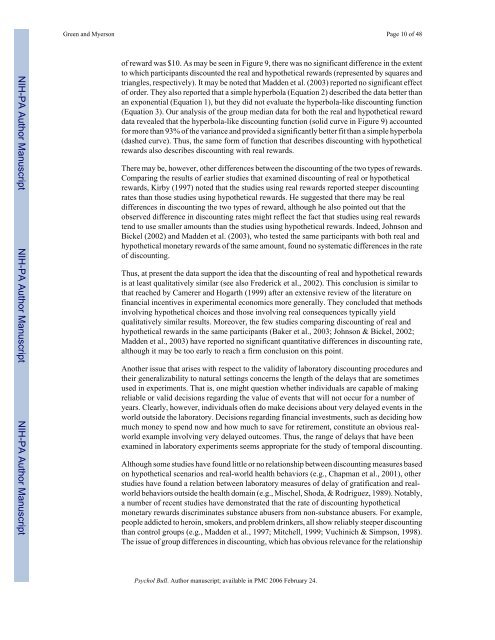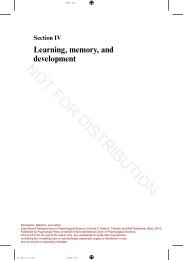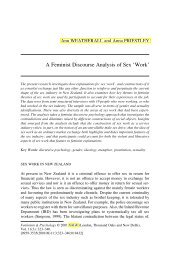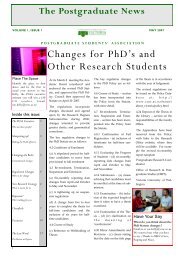green & myerson 2004.. - of /courses
green & myerson 2004.. - of /courses
green & myerson 2004.. - of /courses
You also want an ePaper? Increase the reach of your titles
YUMPU automatically turns print PDFs into web optimized ePapers that Google loves.
Green and Myerson Page 10 <strong>of</strong> 48<br />
NIH-PA Author Manuscript NIH-PA Author Manuscript NIH-PA Author Manuscript<br />
<strong>of</strong> reward was $10. As may be seen in Figure 9, there was no significant difference in the extent<br />
to which participants discounted the real and hypothetical rewards (represented by squares and<br />
triangles, respectively). It may be noted that Madden et al. (2003) reported no significant effect<br />
<strong>of</strong> order. They also reported that a simple hyperbola (Equation 2) described the data better than<br />
an exponential (Equation 1), but they did not evaluate the hyperbola-like discounting function<br />
(Equation 3). Our analysis <strong>of</strong> the group median data for both the real and hypothetical reward<br />
data revealed that the hyperbola-like discounting function (solid curve in Figure 9) accounted<br />
for more than 93% <strong>of</strong> the variance and provided a significantly better fit than a simple hyperbola<br />
(dashed curve). Thus, the same form <strong>of</strong> function that describes discounting with hypothetical<br />
rewards also describes discounting with real rewards.<br />
There may be, however, other differences between the discounting <strong>of</strong> the two types <strong>of</strong> rewards.<br />
Comparing the results <strong>of</strong> earlier studies that examined discounting <strong>of</strong> real or hypothetical<br />
rewards, Kirby (1997) noted that the studies using real rewards reported steeper discounting<br />
rates than those studies using hypothetical rewards. He suggested that there may be real<br />
differences in discounting the two types <strong>of</strong> reward, although he also pointed out that the<br />
observed difference in discounting rates might reflect the fact that studies using real rewards<br />
tend to use smaller amounts than the studies using hypothetical rewards. Indeed, Johnson and<br />
Bickel (2002) and Madden et al. (2003), who tested the same participants with both real and<br />
hypothetical monetary rewards <strong>of</strong> the same amount, found no systematic differences in the rate<br />
<strong>of</strong> discounting.<br />
Thus, at present the data support the idea that the discounting <strong>of</strong> real and hypothetical rewards<br />
is at least qualitatively similar (see also Frederick et al., 2002). This conclusion is similar to<br />
that reached by Camerer and Hogarth (1999) after an extensive review <strong>of</strong> the literature on<br />
financial incentives in experimental economics more generally. They concluded that methods<br />
involving hypothetical choices and those involving real consequences typically yield<br />
qualitatively similar results. Moreover, the few studies comparing discounting <strong>of</strong> real and<br />
hypothetical rewards in the same participants (Baker et al., 2003; Johnson & Bickel, 2002;<br />
Madden et al., 2003) have reported no significant quantitative differences in discounting rate,<br />
although it may be too early to reach a firm conclusion on this point.<br />
Another issue that arises with respect to the validity <strong>of</strong> laboratory discounting procedures and<br />
their generalizability to natural settings concerns the length <strong>of</strong> the delays that are sometimes<br />
used in experiments. That is, one might question whether individuals are capable <strong>of</strong> making<br />
reliable or valid decisions regarding the value <strong>of</strong> events that will not occur for a number <strong>of</strong><br />
years. Clearly, however, individuals <strong>of</strong>ten do make decisions about very delayed events in the<br />
world outside the laboratory. Decisions regarding financial investments, such as deciding how<br />
much money to spend now and how much to save for retirement, constitute an obvious realworld<br />
example involving very delayed outcomes. Thus, the range <strong>of</strong> delays that have been<br />
examined in laboratory experiments seems appropriate for the study <strong>of</strong> temporal discounting.<br />
Although some studies have found little or no relationship between discounting measures based<br />
on hypothetical scenarios and real-world health behaviors (e.g., Chapman et al., 2001), other<br />
studies have found a relation between laboratory measures <strong>of</strong> delay <strong>of</strong> gratification and realworld<br />
behaviors outside the health domain (e.g., Mischel, Shoda, & Rodriguez, 1989). Notably,<br />
a number <strong>of</strong> recent studies have demonstrated that the rate <strong>of</strong> discounting hypothetical<br />
monetary rewards discriminates substance abusers from non-substance abusers. For example,<br />
people addicted to heroin, smokers, and problem drinkers, all show reliably steeper discounting<br />
than control groups (e.g., Madden et al., 1997; Mitchell, 1999; Vuchinich & Simpson, 1998).<br />
The issue <strong>of</strong> group differences in discounting, which has obvious relevance for the relationship<br />
Psychol Bull. Author manuscript; available in PMC 2006 February 24.






